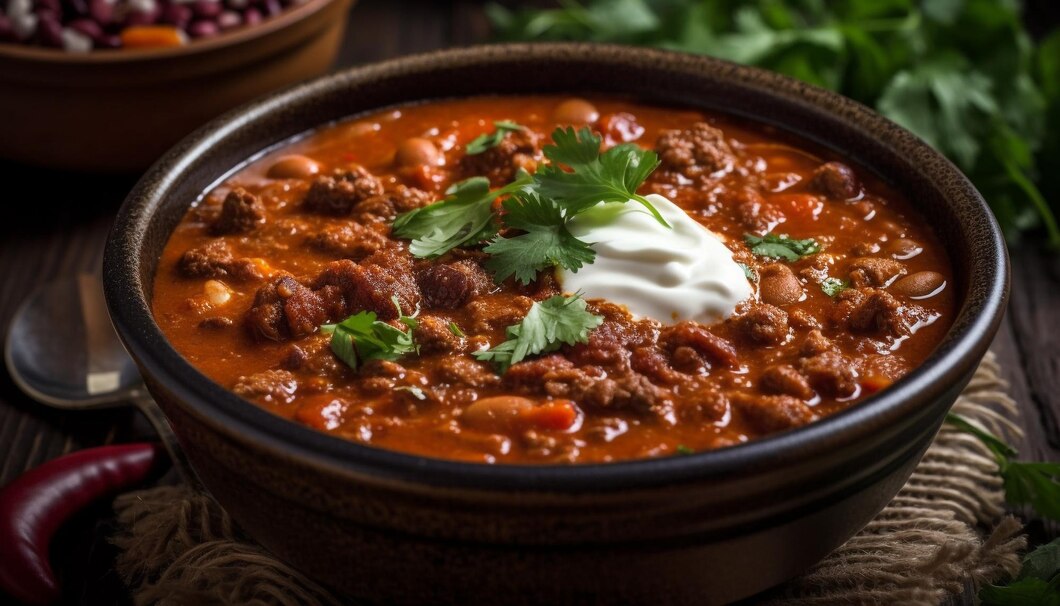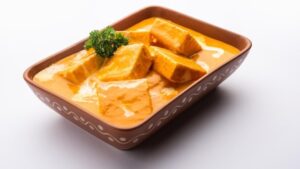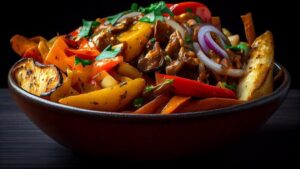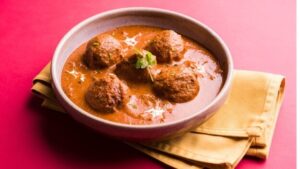Rajma masala is a popular North Indian dish made with kidney beans (rajma) cooked in a thick and flavorful tomato-based curry. It is a vegetarian dish that is commonly enjoyed with rice, particularly basmati rice, or Indian bread like chapati or naan. The kidney beans are soaked, boiled, and then simmered in a spiced tomato gravy, typically featuring ingredients such as onions, tomatoes, garlic, ginger, and a blend of various spices like cumin, coriander, turmeric, garam masala, and red chili powder.
The dish is known for its rich and hearty flavor, often accompanied by a creamy texture due to the use of ingredients like cream or yogurt. Rajma masala is a staple in many North Indian households and is cherished for its comforting taste and nutritional value.
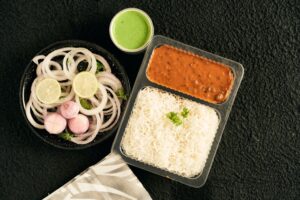
History:
The history of Rajma curry is intertwined with the cultural and culinary traditions of North India. The use of kidney beans in Indian cuisine can be traced to the introduction of beans by the Portuguese during the colonial period. Over time, these beans were integrated into Indian cooking, and various regional variations emerged.
Rajma curry likely originated in the northern states of India, where kidney beans are a popular ingredient. The dish gained popularity in Punjab, Haryana, Himachal Pradesh, and other neighboring regions. It became a wholesome and nutritious dish, providing a good source of protein for vegetarians. Rajma curry is often enjoyed with rice or Indian bread, making it a satisfying and well-balanced meal.
Nutritional Benefits:
Rajma masala, with its combination of kidney beans and an array of spices, offers a range of nutritional benefits. Here’s a detailed breakdown of some key nutritional components:
-
Protein:
- Kidney Beans: These legumes are an excellent source of plant-based protein. Protein is crucial for muscle repair, immune function, and overall growth and development.
-
Fiber:
- Kidney Beans: High in dietary fiber, kidney beans contribute to digestive health by promoting regular bowel movements, preventing constipation, and supporting a healthy gut microbiome.
-
Vitamins:
- Tomatoes: The tomato-based gravy in rajma masala provides vitamins such as vitamin C, which is essential for a healthy immune system and skin health, and vitamin A, important for vision and immune function.
- Onions and Garlic: These aromatic ingredients contribute vitamins like vitamin C, vitamin B6, and various antioxidants that support overall health.
-
Minerals:
- Kidney Beans: Rich in minerals such as iron, magnesium, and potassium. Iron is crucial for preventing anemia, magnesium supports bone health and muscle function, and potassium helps regulate blood pressure.
-
Antioxidants:
- Spices (Cumin, Coriander, Turmeric, etc.): Many of the spices used in rajma masala, such as turmeric, cumin, and coriander, contain antioxidants. These compounds help neutralize free radicals in the body, reducing oxidative stress and inflammation.
-
Heart Health:
- Kidney Beans: The fiber, potassium, and magnesium content in kidney beans contribute to heart health. Fiber helps manage cholesterol levels, while potassium and magnesium help regulate blood pressure.
- Spices: Certain spices like turmeric and garlic have been linked to heart health by supporting healthy blood circulation and cholesterol levels.
-
Blood Sugar Control:
- Fiber: The fiber content in kidney beans aids in controlling blood sugar levels by slowing down the absorption of glucose. This can be beneficial for individuals with diabetes or those looking to maintain stable blood sugar levels.
-
Weight Management:
- Protein and Fiber: The combination of protein and fiber in kidney beans can promote a feeling of fullness, potentially aiding in weight management by reducing overall calorie intake.
-
Anti-Inflammatory Properties:
- Spices (Turmeric, Garlic, Ginger): Turmeric, garlic, and ginger are known for their anti-inflammatory properties, which may help reduce inflammation in the body and support overall health.
While rajma masala is a nutritious dish, it’s essential to be mindful of portion sizes and the overall balance of your diet. Additionally, individual nutritional needs may vary, and consulting with a healthcare professional or nutritionist is recommended for personalized advice.
Pairing Options:
Pairing rajma masala with the right accompaniments enhances the overall dining experience. Here are some popular and delicious pairing options:
-
Steamed Basmati Rice:
- The classic and most common pairing for rajma masala is with steamed basmati rice. The fluffy, aromatic rice complements the rich and flavorful curry, allowing you to savor the combination of textures and tastes.
-
Chapati or Roti:
- Indian bread like chapati or roti is another excellent choice. The soft and slightly chewy texture of these bread varieties provides a perfect contrast to the thick rajma masala. Tear off a piece and scoop up the curry for a delightful bite.
-
Naan:
- Naan, a leavened Indian flatbread, is a favorite for soaking up the savory gravy of rajma masala. Its pillowy texture and slightly crispy exterior make it an indulgent choice for a special meal.
-
Quinoa:
- For a healthier twist, consider pairing rajma masala with quinoa. The nutty flavor and fluffy texture of quinoa complement the curry while adding an extra boost of protein and nutrients to the meal.
-
Jeera Rice (Cumin Rice):
- Fragrant jeera rice, cooked with cumin seeds, is a flavorful option that enhances the overall dining experience. The earthy aroma of cumin pairs well with the spices in the rajma masala.
-
Pulao:
- Vegetable pulao or biryani, with its aromatic and seasoned rice combined with vegetables, can be a delightful and colorful accompaniment to rajma masala. The spices in the pulao can harmonize with those in the curry.
-
Tandoori Roti:
- Tandoori roti, baked in a tandoor (clay oven), has a distinct smoky flavor that pairs well with the robust flavors of rajma masala. Its slightly crispy exterior and soft interior make it a great choice for scooping up the curry.
-
Paratha:
- Stuffed or plain parathas, a type of Indian flatbread, are a hearty option. The layers of flaky dough add a delightful texture, and the warmth of the paratha complements the comforting nature of rajma masala.
-
Cucumber Raita:
- A refreshing cucumber raita on the side can balance the spiciness of the rajma masala. The cool and creamy yogurt-based dip with cucumbers and spices provides a refreshing contrast.
-
Salad:
- A crisp and colorful salad can add freshness to the meal. A simple cucumber-tomato salad with a squeeze of lemon juice and a sprinkle of chaat masala can provide a cool and tangy element.
Feel free to experiment with different pairings based on your preferences, and don’t forget to garnish your rajma masala with fresh cilantro for a burst of freshness. The key is to find a balance that suits your taste and makes your dining experience enjoyable.
Recipe for Rajma Curry:
Ingredients:
- 1 cup dry red kidney beans (Rajma)
- 2 large onions, finely chopped
- 2 large tomatoes, pureed
- 2-3 green chilies, finely chopped
- 1 tablespoon ginger-garlic paste
- 1 teaspoon cumin seeds
- 1 teaspoon turmeric powder
- 1 teaspoon red chili powder
- 1 teaspoon coriander powder
- 1 teaspoon garam masala
- Salt to taste
- 2 tablespoons oil or ghee
- Fresh coriander leaves for garnish
Instructions:
- Soak the Kidney Beans:
- Rinse the kidney beans thoroughly and soak them in water overnight. Alternatively, you can use the quick soak method by boiling the beans for 5 minutes and then letting them soak for an hour.
- Cook the Kidney Beans:
- Drain the soaked beans, add fresh water, and cook them until they are soft and fully cooked. This can be done in a pressure cooker or a regular pot. Once cooked, set the beans aside.
- Prepare the Curry Base:
- In a pan, heat oil or ghee. Add cumin seeds and let them splutter.
- Add chopped onions and sauté until golden brown.
- Add green chilies and ginger-garlic paste. Sauté for a few minutes until the raw smell disappears.
- Add tomato puree and cook until the oil separates from the masala.
- Add Spices:
- Add turmeric powder, red chili powder, coriander powder, and salt. Mix well and cook for a few more minutes.
- Combine with Kidney Beans:
- Add the cooked kidney beans to the masala. Mix well and let it simmer for about 15-20 minutes, allowing the flavors to meld.
- Finish with Garam Masala:
- Add garam masala and cook for an additional 5 minutes. Adjust salt and spice levels according to your taste.
- Garnish and Serve:
- Garnish with fresh coriander leaves and serve the Rajma curry hot with rice or Indian bread (naan, roti).
Rajma curry is not only delicious but also a nutritious and hearty dish that has become a favorite in many households, both in India and around the world.

